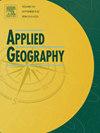使用地形衍生指数和环境成分来检查沿美国-墨西哥边境的无证移民死亡率的空间背景
IF 5.4
2区 地球科学
Q1 GEOGRAPHY
引用次数: 0
摘要
环境暴露是美国-墨西哥边境图森地区无证移民死亡的主要可识别原因。本文研究了1981年至2023年间环境因素在预测移民死亡地点中的作用(n = 3427)。利用高分辨率地形表面和地理空间技术为面板线性建模框架推导出一套环境指标,我们发现潜在蒸散发是死亡地点的最强预测因子。自2011年以来,潜在蒸散量每增加1毫米/天,预测死亡地点的概率比随机地点高14.85%。太阳直接辐射每增加1小时,预测死亡地点的机会降低2%,斜率也有相同的趋势,每度降低1.094%。总体而言,死亡地点位于干旱地区(p <;0.001),接受太阳直接辐射的时间较短(p <;0.001),更平坦(p <;0.001),并且更靠近美国-墨西哥边境(p <;0.001)比随机。这些发现表明,长时间暴露在严重干旱中,而不是暴露在太阳直接辐射下,对可能发生死亡的地方影响最大。本文章由计算机程序翻译,如有差异,请以英文原文为准。
Using terrain-derived indices and environmental components to examine the spatial context of undocumented immigrant mortality along the USA–MEX border
Environmental exposure is the leading identifiable cause of mortality for undocumented immigrants the Tucson Sector of the USA–Mexico border. This paper investigates the role of environmental components in predicting immigrant mortality sites between 1981 and 2023 (n = 3427). Using a high-resolution terrain surface and geospatial techniques to derive a suite of environmental metrics for a panel linear modeling framework, we found that potential evapotranspiration was the strongest predictor of mortality location. Since 2011, for every 1 mm/day increase in potential evapotranspiration, the probability of predicting a mortality site was 14.85 % higher than a random location. A 1-hr increase in direct solar radiation decreased the chance of predicting a mortality site by 2 % and slope followed the same trend at 1.094 % decrease per degree. Overall, mortality sites were situated in areas that were drier (p < 0.001), received direct solar radiation for less time (p < 0.001), were flatter (p < 0.001), and were nearer the USA–MEX border (p < 0.001) than random. These findings suggest that exposure to severe aridity for prolonged periods, rather than time spent in direct solar radiation, most influences where mortality is likely to occur.
求助全文
通过发布文献求助,成功后即可免费获取论文全文。
去求助
来源期刊

Applied Geography
GEOGRAPHY-
CiteScore
8.00
自引率
2.00%
发文量
134
期刊介绍:
Applied Geography is a journal devoted to the publication of research which utilizes geographic approaches (human, physical, nature-society and GIScience) to resolve human problems that have a spatial dimension. These problems may be related to the assessment, management and allocation of the world physical and/or human resources. The underlying rationale of the journal is that only through a clear understanding of the relevant societal, physical, and coupled natural-humans systems can we resolve such problems. Papers are invited on any theme involving the application of geographical theory and methodology in the resolution of human problems.
 求助内容:
求助内容: 应助结果提醒方式:
应助结果提醒方式:


